Influence of Rare Earth Elements on the Radiation-Shielding Behavior of Serpentinite-Based Materials
Abstract
1. Introduction
2. Materials and Methods
2.1. High-Energy Spectroscopy Experiments
2.2. Elemental and Structural Analysis
3. Results
3.1. Mineralogy–Geochemistry
3.2. Elemental and Structural Analysis Results
3.3. Mineralogy–Geochemistry and Elemental and Structural Analysis
3.4. High-Energy Spectroscopy Experiment Results
4. Conclusions
- It is found that serpentinite minerals are ferromagnesian. Nickel is the most abundant heavy metal analyzed in serpentinites. Serpentinites, formed by the hydration of silica-poor olivine at low temperatures, may consist of antigorite, chrysotile, or lizardite. The optical properties and chemical composition of the selected samples indicate that they are predominantly composed of antigorite.
- The presence of REE elements in the serpentinite structure influences the thermal neutron cross-sections, while the LOI (crystalline H2O) content affects the fast neutron cross-sections.
- It was found that the radiation-shielding behavior followed the following order, Sr-2> Sr-5 > Sr-3> Sr-4> Sr-1, for thermal and fast neutrons and γ-rays. The fast neutron-absorption equivalent dose rates (μSv/h) of the serpentinite samples’ behavior followed the following order: Sr-2< Sr-5 < Sr-3< Sr-4< Sr-1.
- Sr-2 exhibits an HVL of 1.8143 cm for thermal neutrons, which is approximately 58% lower than the typical HVL of standard concrete (~4.30 cm). The Sr-2 samples are more convenient and competent for radiation shielding compared to the other serpentinite samples.
- Due to their specific mineralogical composition and geochemical characteristics, serpentinite formations show strong potential as effective shielding materials against fast neutrons and gamma radiation in nuclear environments. In the serpentinite sample with antigorite composition, the gamma ray test revealed the significant impact of pores on radiation-shielding properties; it was observed that when the pores are empty, radiation can pass through directly without any deviation.
Author Contributions
Funding
Institutional Review Board Statement
Informed Consent Statement
Data Availability Statement
Acknowledgments
Conflicts of Interest
References
- Shi, J.; Tian, G.; Zhang, Z.; Zou, P.; Li, H.; Wang, Y.; Zhang, J. Effect of graphene quantum dots and curing ways on properties of serpentine mortar. Mater. Lett. 2025, 385, 138134. [Google Scholar] [CrossRef]
- Abdalla, A.M.; Al-Naggar, T.I.; Bashiri, A.M.; Alsareii, S.A. Radiation shielding performance for local granites. Prog. Nucl. Energy 2022, 150, 104294. [Google Scholar] [CrossRef]
- Abrefah, R.G.; Tuffour-Achampong, K.; Amoah, P. Effectiveness of serpentine concrete as shielding material for neutron source facility using Monte Carlo code. Sci. Technol. Nucl. Install. 2023, 2023, 8986638. [Google Scholar] [CrossRef]
- Akkurt, I.; Altindag, R.; Onargan, T.; Basyigit, C.; Kılıncarslan, S.; Kun, M.; Mavi, B.; Güney, A. The properties of various igneous rocks for γ-ray shielding. Constr. Build. Mater. 2007, 21, 2078–2082. [Google Scholar] [CrossRef]
- Ruch, M.L.; Flaska, M.; Pozzi, S.A. Pulse shape discrimination performance of stilbene coupled to low-noise silicon photomultipliers. Nucl. Instrum. Methods Phys. Res. A 2015, 793, 1–5. [Google Scholar] [CrossRef]
- Vega-Carrillo, H.R.; Manzanares-Acuña, E.; Becerra-Ferreiro, A.; Carrillo-Nuñez, A. Neutron and gamma-ray spectra of 239PuBe and 241AmBe. Appl. Radiat. Isot. 2002, 57, 167–170. [Google Scholar] [CrossRef]
- Saglime, F.J.; Danon, Y.; Block, R.C.; Rapp, M.J.; Bahran, R.M.; Leinweber, G.; Barry, D.P.; Drindak, N.J. A system for differential neutron scattering experiments in the energy range from 0.5 to 20 MeV. Nucl. Instrum. Methods Phys. Res. A 2010, 620, 401–409. [Google Scholar]
- Masoud, M.A.; El-Khayatt, A.M.; Shahien, M.G.; Bakhit, B.R.; Suliman, I.I.; Zayed, A.M. Radiation attenuation assessment of serpentinite rocks from a geological perspective. Toxics 2022, 10, 697. [Google Scholar] [CrossRef]
- Kansouh, W.A. Radiation distribution through serpentine concrete using local materials and its application as a reactor biological shield. Ann. Nucl. Energy 2012, 47, 258–263. [Google Scholar] [CrossRef]
- Masoud, M.A.; El-Khayatt, A.M.; Kansouh, W.A.; Sakr, K.; Shahien, M.G.; Zayed, A.M. Insights into the effect of the mineralogical composition of serpentine aggregates on the radiation attenuation properties of their concretes. Constr. Build. Mater. 2020, 263, 120141. [Google Scholar] [CrossRef]
- Mymrin, V.; Presotto, P.; Alekseev, K.; Avanci, M.A.; Rolim, P.H.; Petukhov, V.; Taskin, A.; Gidarakos, E.; Valouma, A.; Yu, G. Application of hazardous serpentine rocks’ extraction wastes in composites with glass waste and clay-sand mix to produce environmentally clean construction materials. Constr. Build. Mater. 2020, 234, 117319. [Google Scholar] [CrossRef]
- Libeesh, N.K.; Naseer, K.A.; Arivazhagan, S.; Abd El-Rehim, A.F.; Mahmoud, K.A.; Sayyed, M.I.; Khandaker, M.U. Advanced nuclear radiation shielding studies of some mafic and ultramafic complexes with lithological mapping. Radiat. Phys. Chem. 2021, 189, 109777. [Google Scholar] [CrossRef]
- Libeesh, N.K.; Naseer, K.A.; Arivazhagan, S.; El-Rehim, A.F.A.; Al-Misned, G.; Tekin, H.O. Characterization of ultramafic–alkaline–carbonatite complex for radiation shielding competencies: An experimental and Monte Carlo study with lithological mapping. Ore Geol. Rev. 2022, 142, 104735. [Google Scholar] [CrossRef]
- Çelen, Y.Y.; Akkurt, I.; Ceylan, Y.; Atçeken, H. Application of experiment and simulation to estimate radiation shielding capacity of various rocks. Arab. J. Geosci. 2021, 14, 1471. [Google Scholar] [CrossRef]
- Obaid, S.S.; Sayyed, M.I.; Gaikwad, D.K.; Pawar, P.P. Attenuation coefficients and exposure buildup factor of some rocks for gamma ray shielding applications. Radiat. Phys. Chem. 2018, 148, 86–94. [Google Scholar] [CrossRef]
- Zhu, R.-Z.; Lai, S.-C.; Qin, J.-F.; Zhao, S.-W.; Santosh, M. Petrogenesis of high-K calc-alkaline granodiorite and its enclaves from the SE Lhasa block, Tibet (SW China): Implications for recycled subducted sediments. GSA Bull. 2019, 131, 1224–1238. [Google Scholar] [CrossRef]
- Günoğlu, K.; Akkurt, I.; Sayyed, M.I. Radiation shielding properties of some igneous rocks in Isparta Province at different gamma energies: Experimental and theoretical study. J. Radiat. Res. Appl. Sci. 2024, 17, 100796. [Google Scholar] [CrossRef]
- Tekin, H.O.; Sayyed, M.I.; Issa, S.A. Gamma radiation shielding properties of the hematite-serpentine concrete blended with WO3 and Bi2O3 micro and nano particles using MCNPX code. Radiat. Phys. Chem. 2018, 150, 95–100. [Google Scholar] [CrossRef]
- Baalamurugan, J.; Kumar, V.G.; Chandrasekaran, S.; Balasundar, S.; Venkatraman, B.; Padmapriya, R.; Raja, V.B. Utilization of induction furnace steel slag in concrete as coarse aggregate for gamma radiation shielding. J. Hazard. Mater. 2019, 369, 561–568. [Google Scholar] [CrossRef]
- Çullu, M.; Bakırhan, E. Investigation of radiation absorption coefficients of lead-zinc mine waste rock mixed heavy concrete at 662–1460 keV energy range. Constr. Build. Mater. 2018, 173, 17–27. [Google Scholar] [CrossRef]
- Saeed, A.; Alomairy, S.; Sriwunkum, C.; Al-Buriahi, M.S. Neutron and charged particle attenuation properties of volcanic rocks. Radiat. Phys. Chem. 2021, 184, 109454. [Google Scholar] [CrossRef]
- Mahmoud, K.A.; Sayyed, M.I.; Tashlykov, O.L. Gamma ray shielding characteristics and exposure buildup factor for some natural rocks using MCNP-5 code. Nucl. Eng. Technol. 2019, 51, 1835–1841. [Google Scholar] [CrossRef]
- Arivazhagan, S.; Naseer, K.A.; Mahmoud, K.A.; Arun Kumar, K.V.; Libeesh, N.K.; Sayyed, M.I.; Alqahtani, M.S.; Yousef, E.S.; Khandaker, M.U. Gamma-ray protection capacity evaluation and satellite data based mapping for the limestone, charnockite, and gneiss rocks in the Sirugudi Taluk of the Dindigul district, India. Radiat. Phys. Chem. 2022, 196, 110108. [Google Scholar] [CrossRef]
- Comboni, D.; Pagliaro, F.; Gatta, G.D.; Lotti, P.; Battiston, T.; Merlini, M.; Hanfland, M. Phase transition and high-pressure behavior of ulexite, a potential aggregate in radiation-shielding concretes. Constr. Build. Mater. 2021, 291, 123188. [Google Scholar] [CrossRef]
- Zayed, A.M.; Masoud, M.A.; Shahien, M.G.; Gökçe, H.S.; Sakr, K.; Kansouh, W.A.; El-Khayatt, A.M. Physical, mechanical, and radiation attenuation properties of serpentine concrete containing boric acid. Constr. Build. Mater. 2021, 272, 121641. [Google Scholar] [CrossRef]
- Kılıç, A.D.; İnceöz, M. Mineralogical, geochemical and isotopic effect of silica in ultramafic systems, Eastern Anatolian Turkey. Geochem. Int. 2015, 53, 369–382. [Google Scholar] [CrossRef]
- Dąbrowski, M.; Jóźwiak-Niedźwiedzka, D.; Bogusz, K.; Glinicki, M.A. Influence of serpentinite aggregate on the microstructure and durability of radiation shielding concrete. Constr. Build. Mater. 2022, 337, 127536. [Google Scholar] [CrossRef]
- Oto, B.; Çakar, N.; Kavaz, E.; Madak, M. An experimental study on gamma radiation attenuation effectiveness of magnetite and serpentine doped ceramics. Prog. Nucl. Energy 2024, 169, 105079. [Google Scholar] [CrossRef]
- Zayed, A.M.; Masoud, M.A.; Rashad, A.M.; El-Khayatt, A.M.; Sakr, K.; Kansouh, W.A.; Shahien, M.G. Influence of heavyweight aggregates on the physico-mechanical and radiation attenuation properties of serpentine-based concrete. Constr. Build. Mater. 2020, 260, 120473. [Google Scholar] [CrossRef]
- Sayyadi, A.; Younesi, M.Y.; Rahimi, A.M. Effect of serpentine aggregates on the shielding, mechanical, and durability properties of heavyweight concrete. Int. J. Eng. Trans. B Appl. 2022, 35, 2256–2264. [Google Scholar] [CrossRef]
- Yastrebinskii, R.N.; Bondarenko, G.G.; Pavlenko, V.I. Attenuation of photon and neutron radiation using iron–magnetite–serpentinite radiation-protective composite. Inorg. Mater. Appl. Res. 2017, 8, 275–278. [Google Scholar] [CrossRef]
- Castley, D.; Goodwin, C.; Liu, J. Computational and experimental comparison of boron carbide, gadolinium oxide, samarium oxide, and graphene platelets as additives for a neutron shield. Radiat. Phys. Chem. 2019, 165, 108435. [Google Scholar] [CrossRef]
- Hidaka, H.; Ebihara, M.; Yoneda, S. Neutron capture effects on samarium, europium, and gadolinium in Apollo 15 deep drill-core samples. Meteorit. Planet. Sci. 2000, 35, 581–589. [Google Scholar] [CrossRef]
- Yang, X.; Song, L.; Chang, B.; Yang, Q.; Mao, X.; Huang, Q. Development of Gd-Si-O dispersed 316L stainless steel for improving neutron shielding performance. Nucl. Mater. Energy 2020, 23, 100739. [Google Scholar] [CrossRef]
- Hila, F.C.; Asuncion-Astronomo, A.; Dingle, C.A.M.; Jecong, J.F.M.; Javier-Hila, A.M.V.; Gili, M.B.Z.; Balderas, C.V.; Lopez, G.E.P.; Guillermo, N.R.D.; Amorsolo, A.V. EpiXS: A Windows-based program for photon attenuation, dosimetry and shielding based on EPICS2017 (ENDF/B-VIII) and EPDL97 (ENDF/B-VI.8). Radiat. Phys. Chem. 2021, 182, 109331. [Google Scholar] [CrossRef]
- Şakar, E.; Özpolat, Ö.F.; Alım, B.; Sayyed, M.I.; Kurudirek, M. Phy-X/PSD: Development of a user friendly online software for calculation of parameters relevant to radiation shielding and dosimetry. Radiat. Phys. Chem. 2020, 166, 108496. [Google Scholar] [CrossRef]
- Gökçe, H.S.; Güngör, O.; Yılmaz, H. An online software to simulate the shielding properties of materials for neutrons and photons: NGCal. Radiat. Phys. Chem. 2021, 185, 109519. [Google Scholar] [CrossRef]
- Şasmaz, A.; Kılıç, A.D.; Konakcı, N. Chemichal and thermal changes in Mg3Si2O5(OH)4 polymorph minerals and importance as an industrial material. Preprints 2024. [Google Scholar] [CrossRef]
- Yıldırım, Ö. Investigation of Phase Changes of Serpentine Minerals: Guleman Ophiolite Example. Master’s Thesis, Institute of Science, Fırat University, Elazığ, Türkiye, 2024. [Google Scholar]
- Graham, R.C.; Diallo, M.M.; Lund, L.J. Soils and mineral weathering on phyllite colluvium and serpentinite in Northwestern California. Soil Sci. Soc. Am. J. 1990, 54, 1682–1690. [Google Scholar] [CrossRef]
- El-Khayatt, A.M. Calculation of fast neutron removal cross-sections for some compounds and materials. Ann. Nucl. Energy 2010, 37, 218–222. [Google Scholar] [CrossRef]
- Gaylan, Y.; Bozkurt, A.; Avar, B. Investigating thermal and fast neutron shielding properties of B4C, B2O3, Sm2O3, and Gd2O3 doped polymer matrix composites using Monte Carlo simulations. Süleyman Demirel Univ. Fac. Sci. J. 2021, 16, 490–499. [Google Scholar] [CrossRef]
- Li, X.; Cui, D.; Zou, C.; Ren, C.; Chen, J. Neutron shielding analysis for a gadolinium doped nickel alloy. Mater. Today Commun. 2024, 38, 107933. [Google Scholar] [CrossRef]
- Zhou, Y.; Chen, X.; Zhan, Y.; Xue, Z.; Hu, J.; Wang, X.; Zhu, M.; Li, D. Research on thermal neutron shielding effect of serpentine concrete (SC). Radiat. Phys. Chem. 2025, 229, 112535. [Google Scholar] [CrossRef]
- Singh, S.; Kumar, A.; Singh, D.; Thind, K.S.; Mudahar, G.S. Barium–borate–flyash glasses: As radiation shielding materials. Nucl. Instrum. Methods Phys. Res. B 2008, 266, 140–146. [Google Scholar] [CrossRef]
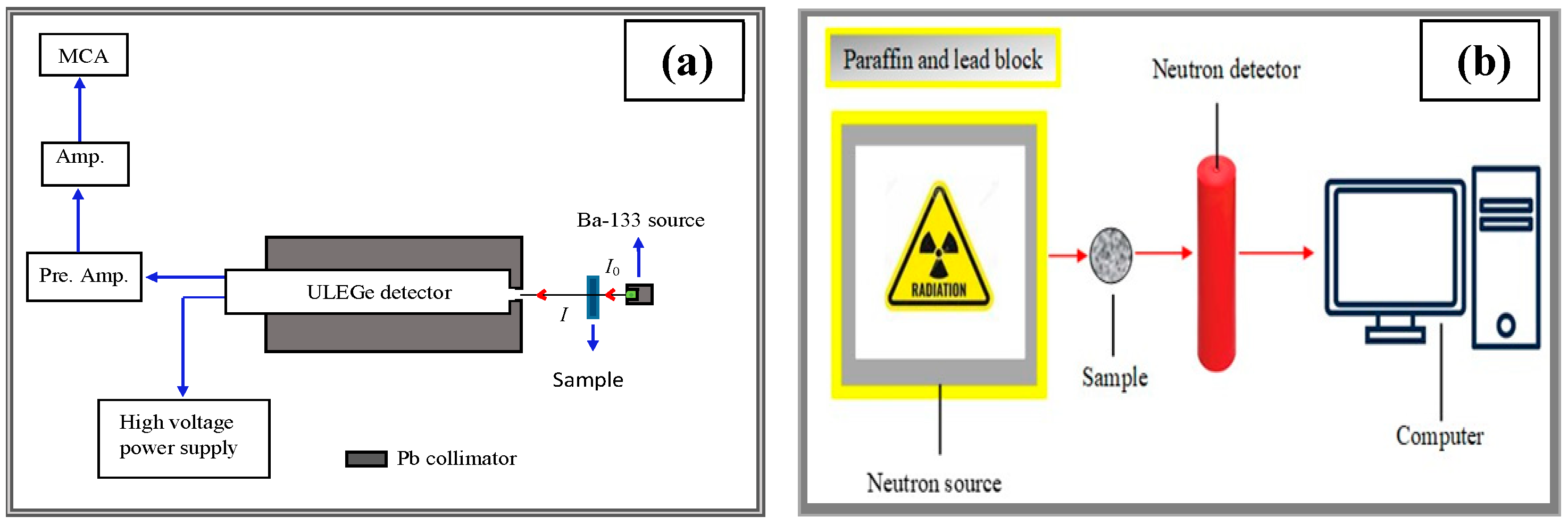

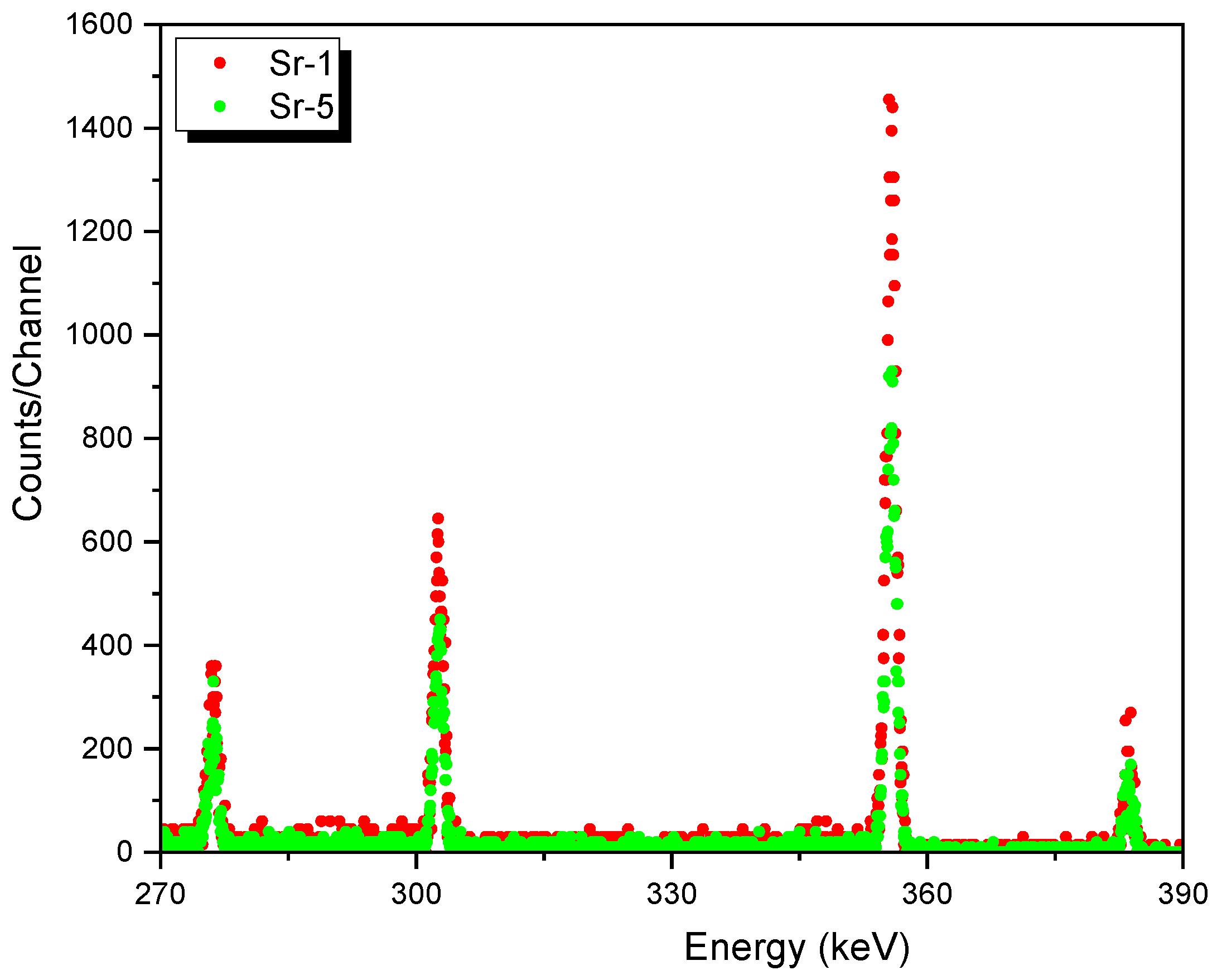
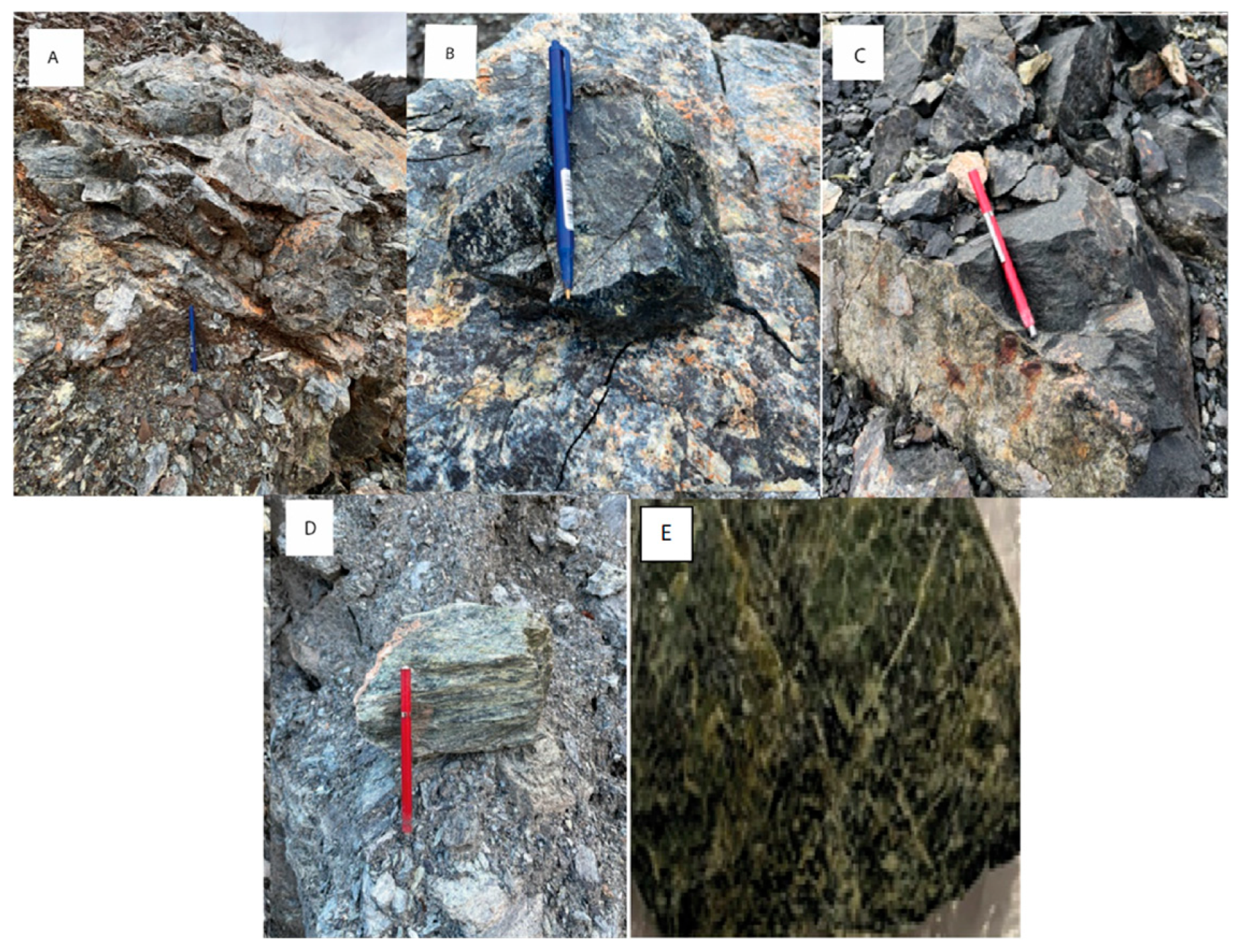
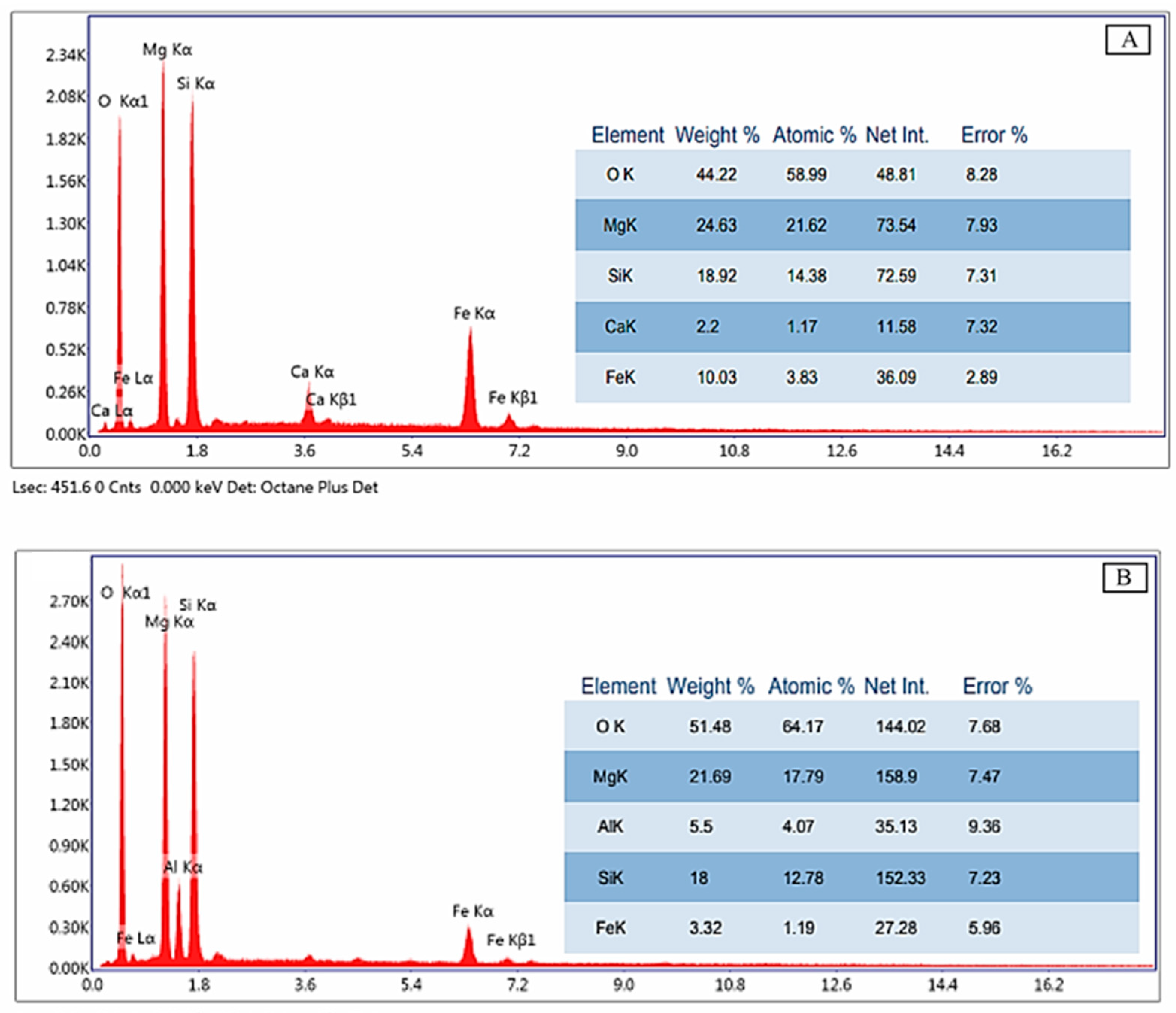
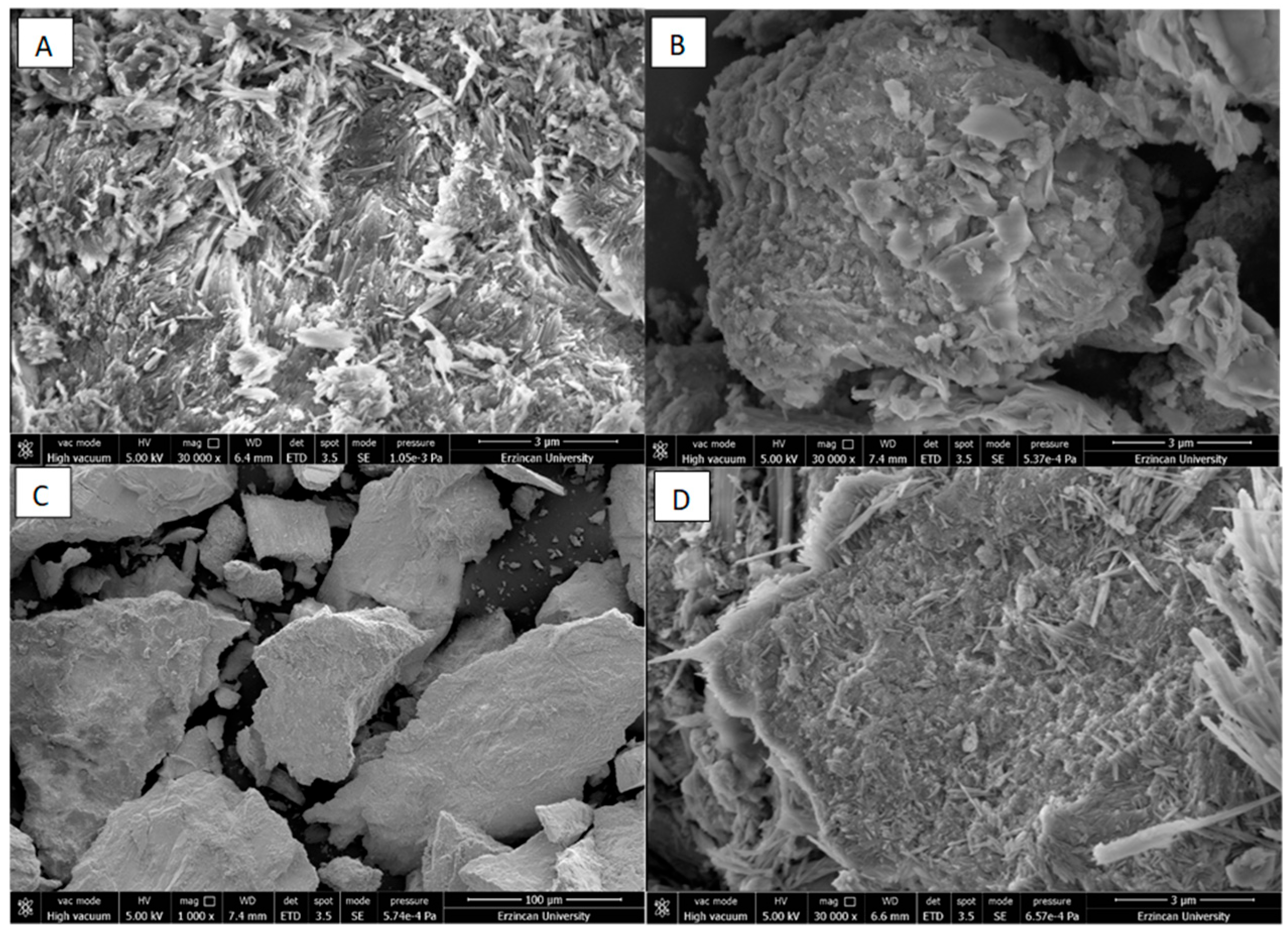
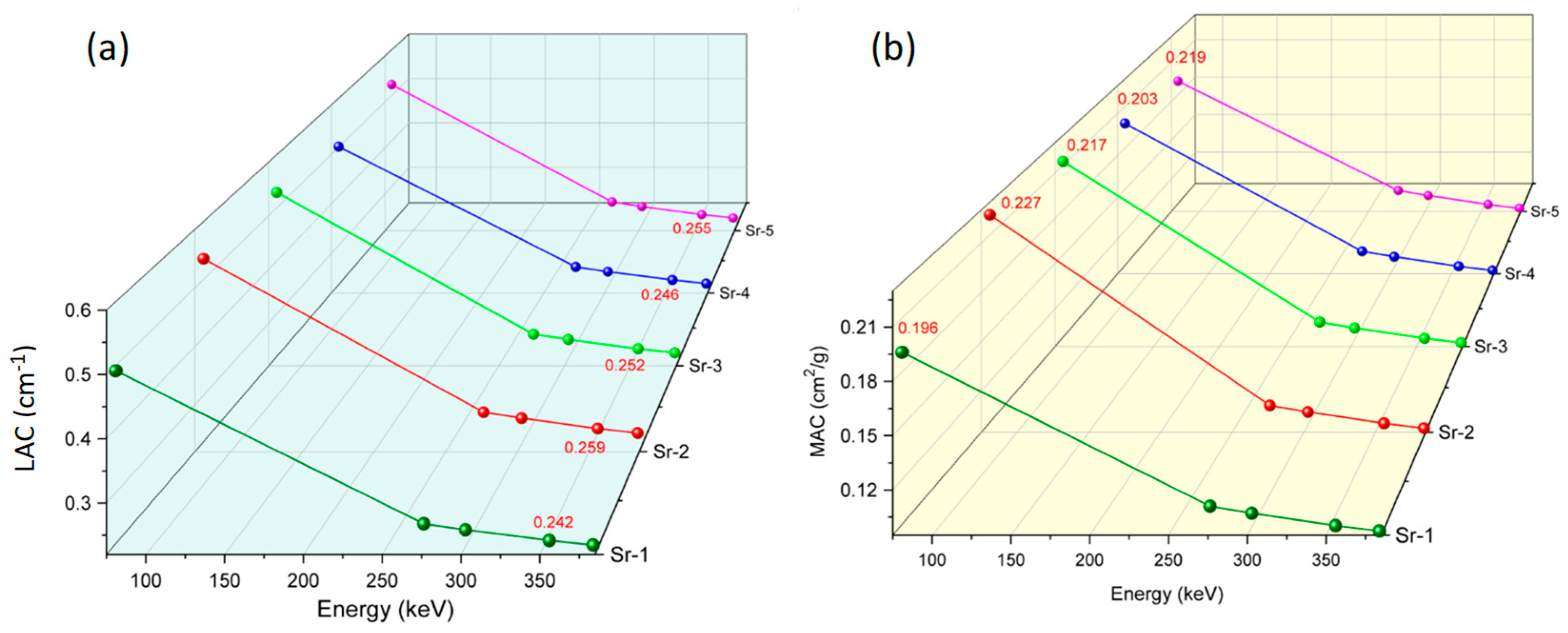
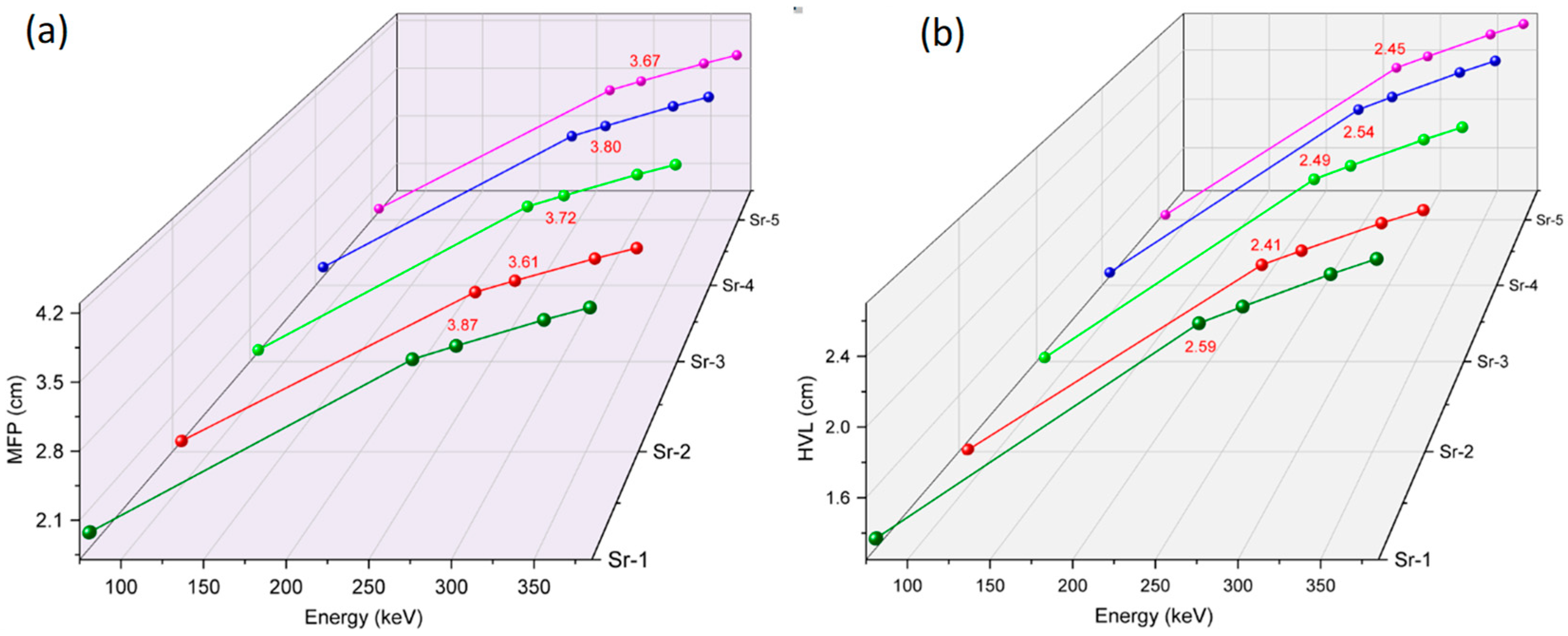
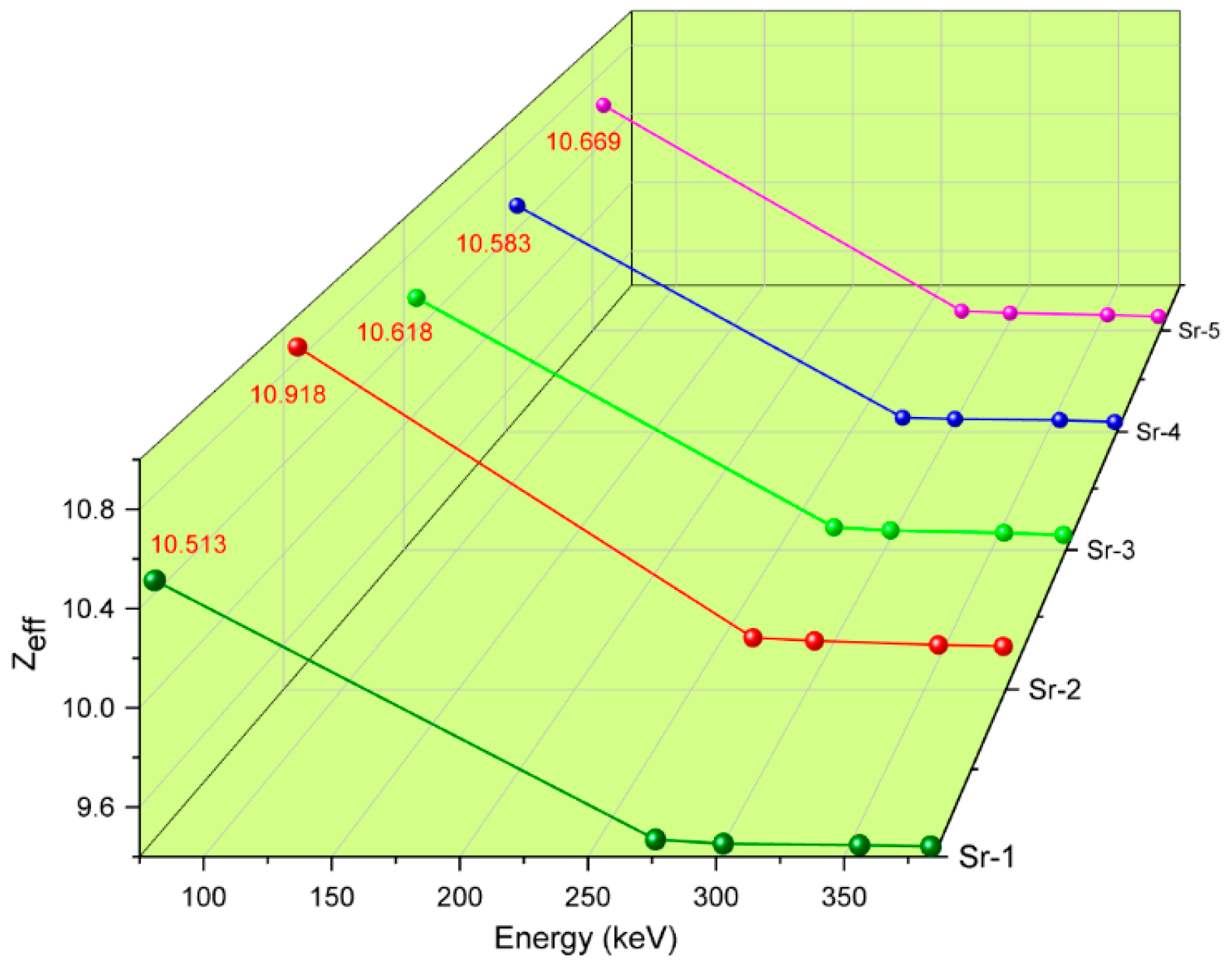
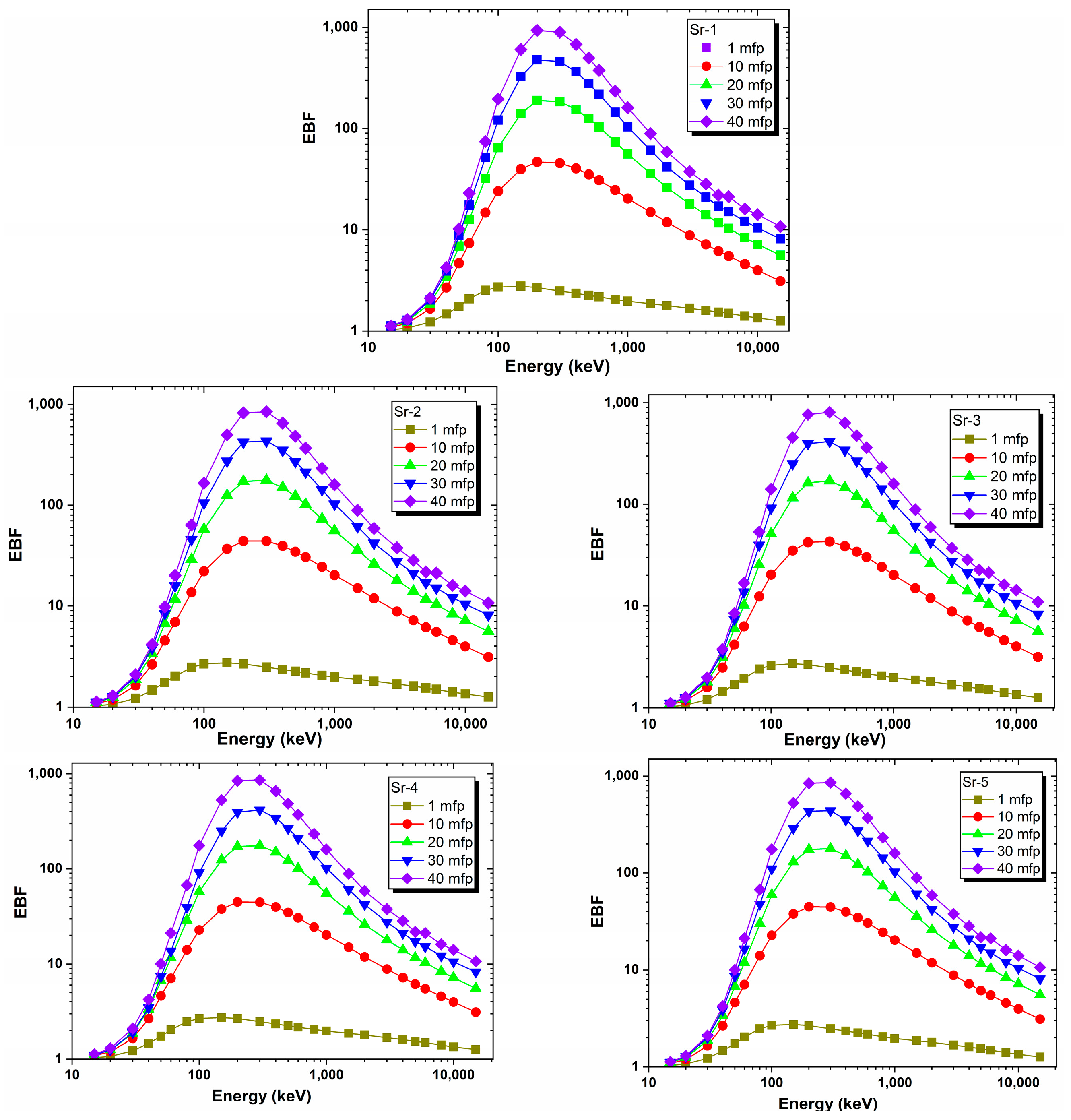
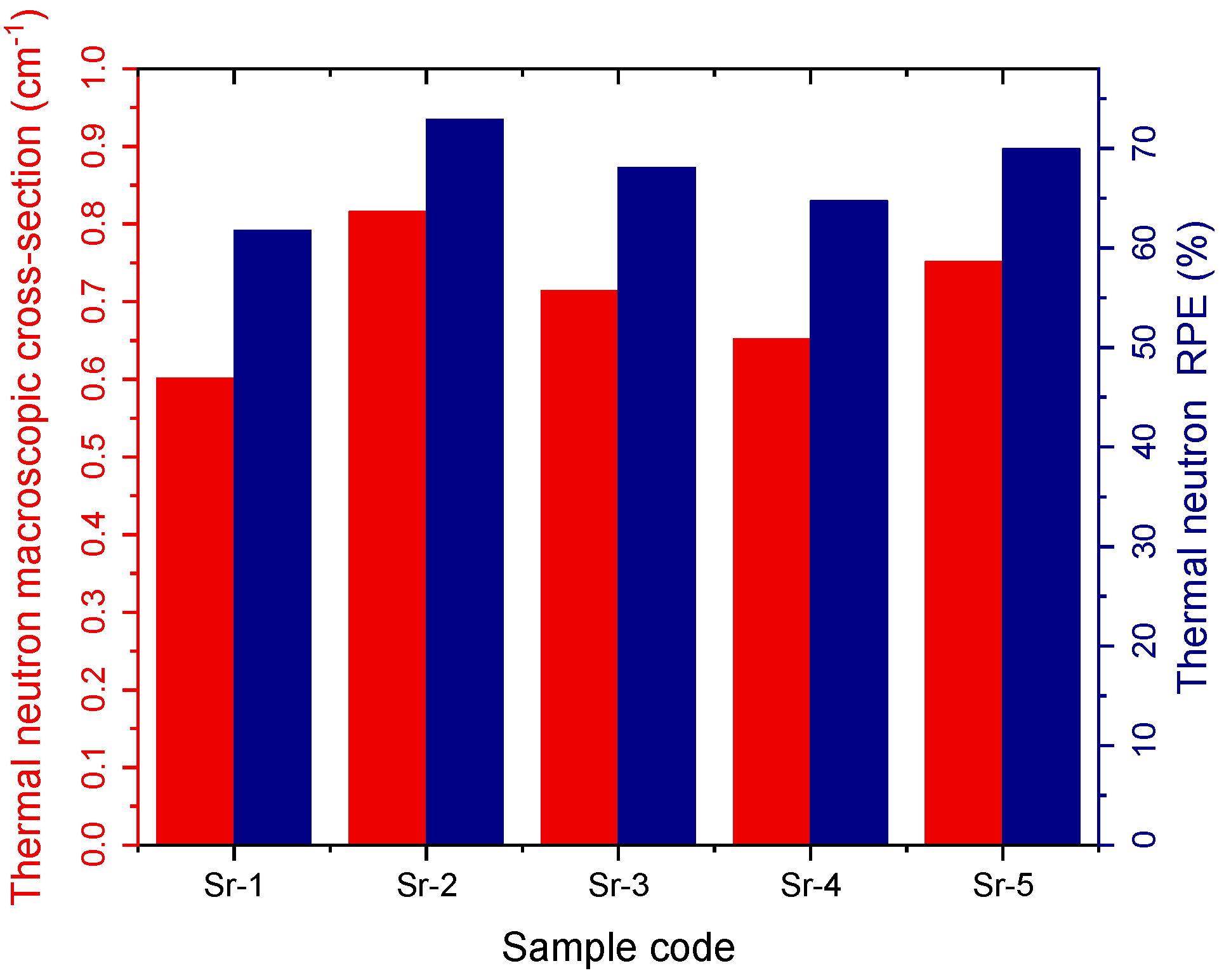
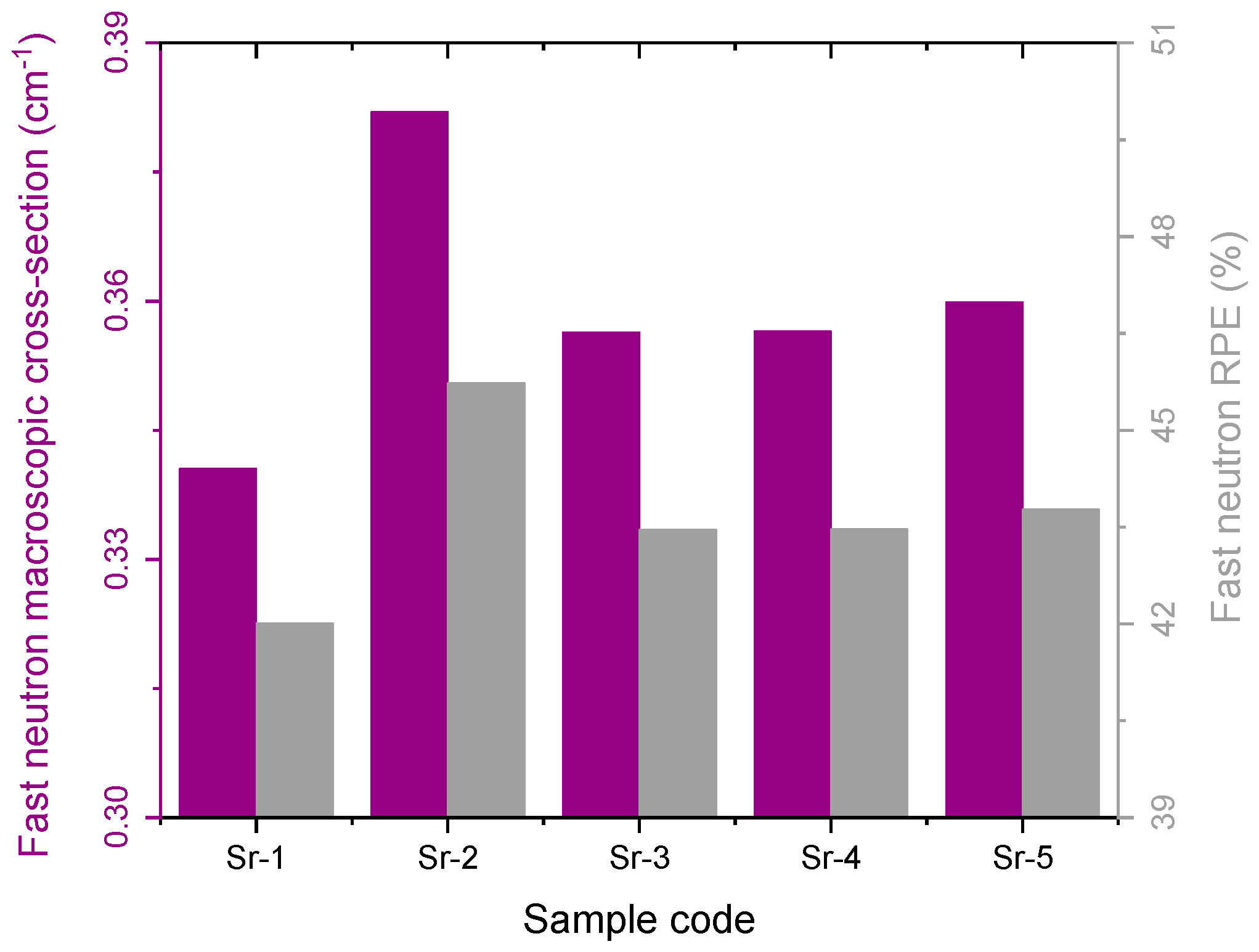
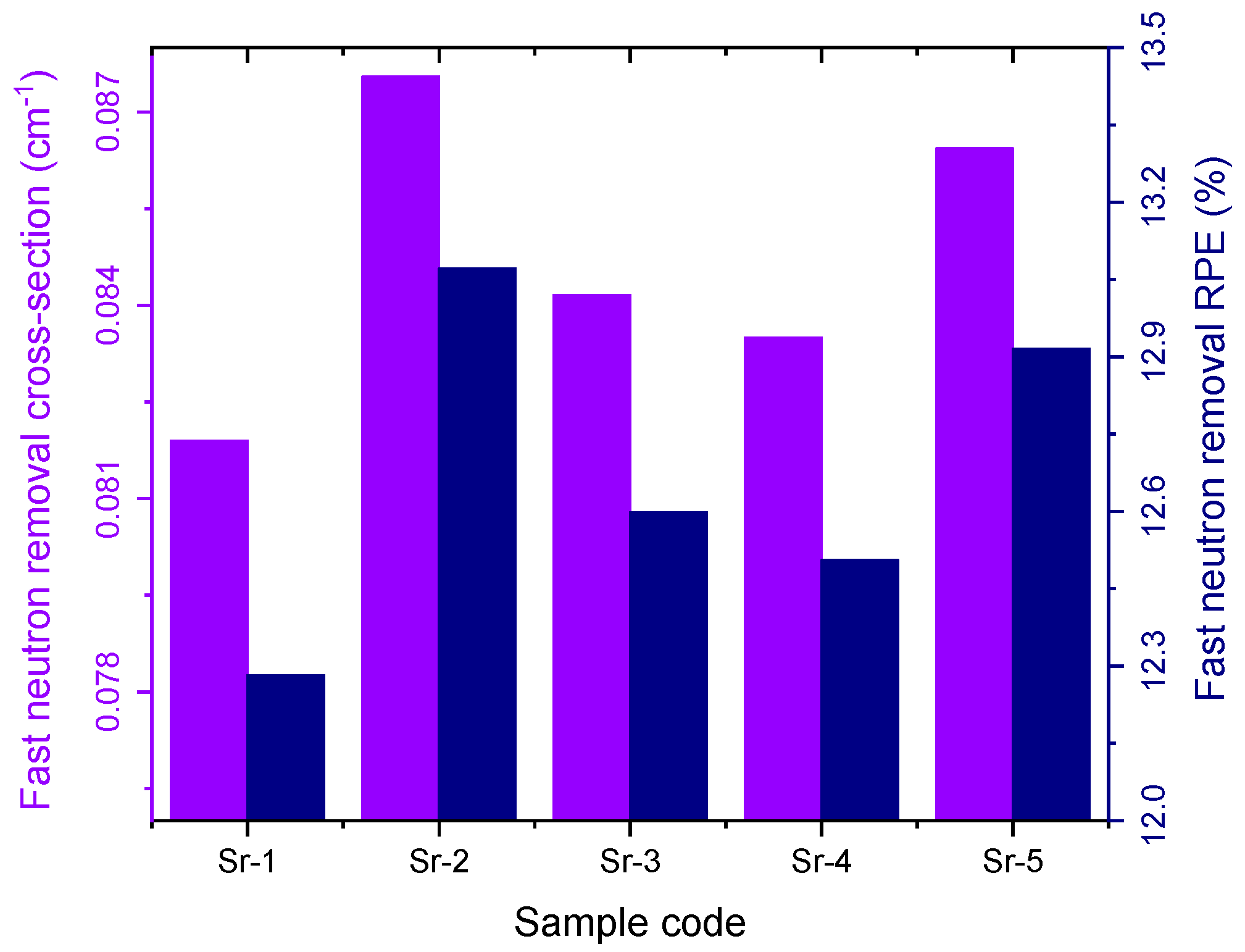
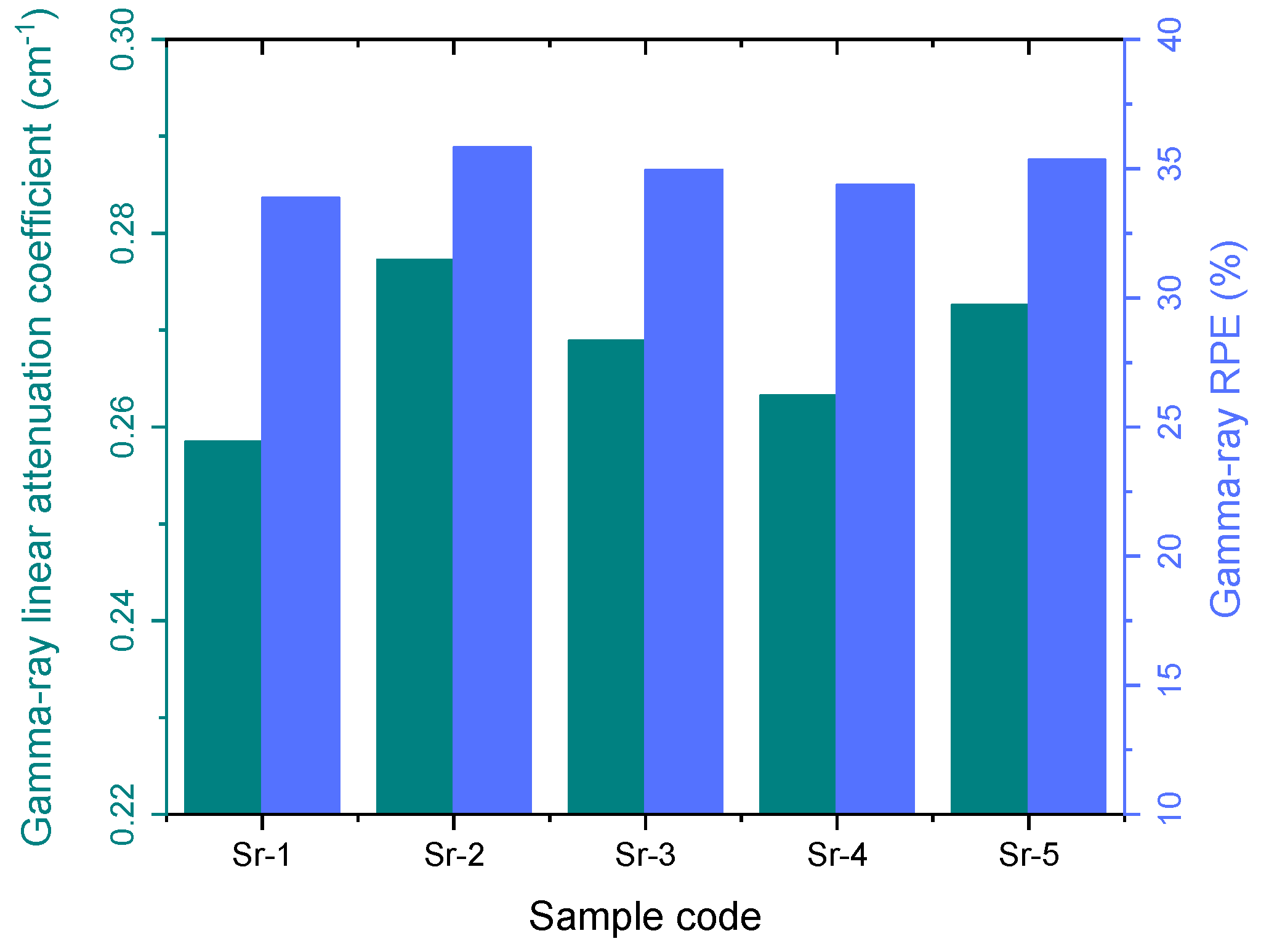
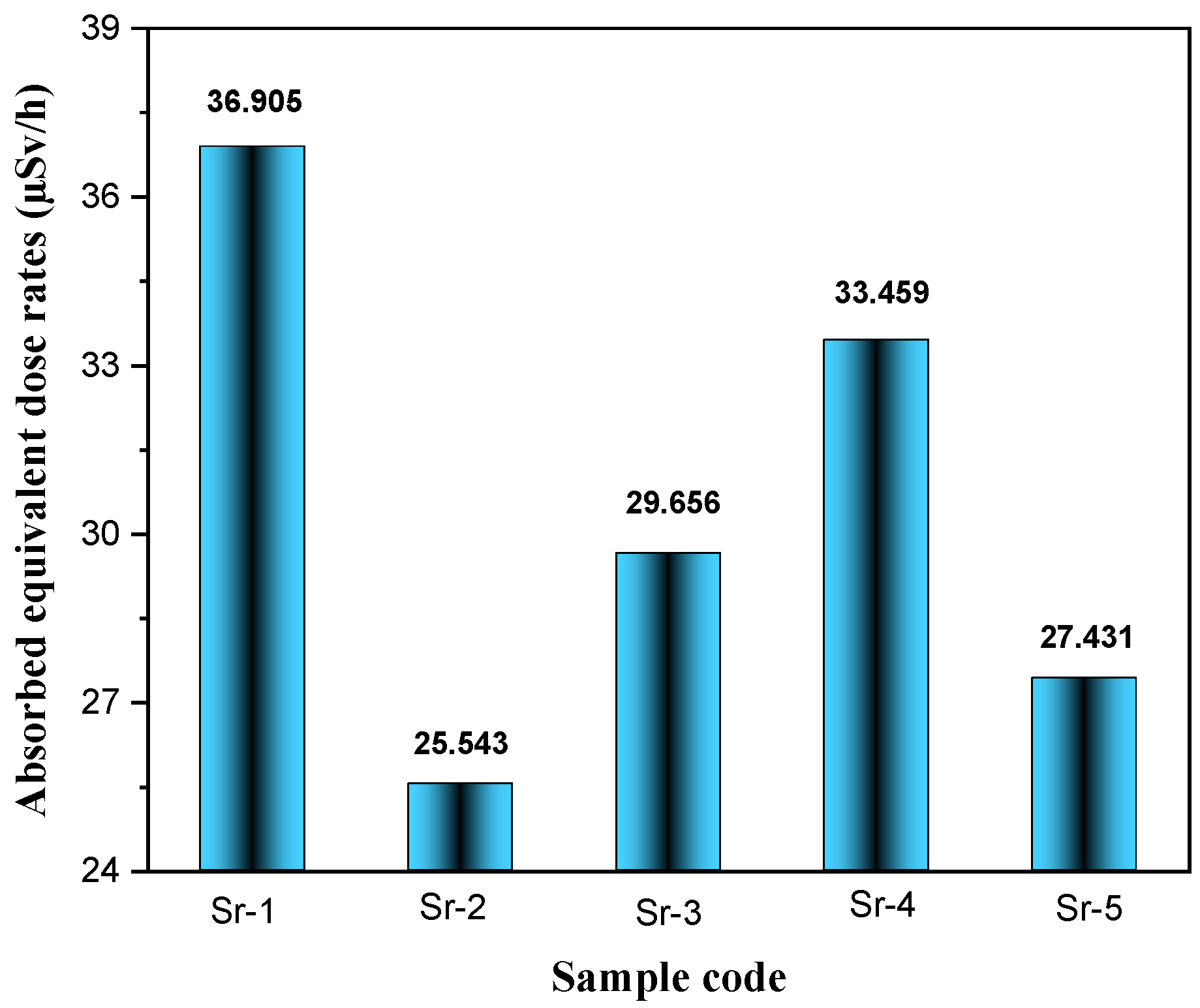
| Parameters | Equations | Descriptions |
|---|---|---|
| Linear attenuation coefficients, (LAC, cm−1) 1 | and are the intensities of the incident photons and those passing through the absorber, respectively. | |
| Mass attenuation coefficients, (MAC, cm2/g) 1 | is the density and is thickness. | |
| Mean free path, (MFP, cm) 1 | MFP is the part traveled by radiation between two collisions. and are the linear attenuation coefficient and neutron macroscopic cross-section, respectively. | |
| Half value thickness, (HVL, cm) 1 | HVL is the thickness of the material that reduces incoming radiation by half. | |
| Effective atomic number 1 | The total electronic cross-section is and the total atomic cross-section is . | |
| Radiation-protection efficiency, RPE | and are the intensities of the incident radiation and those passing through the absorber, respectively. | |
| Buildup factor 1 | is the buildup factor. | |
| Fast neutron removal cross-section 2 | Fast neutron removal cross-section of the ith element is denoted by , while represents its partial density. | |
| Thermal and fast neutron macroscopic cross-section 3 | and are incident and transmitted intensities for thermal and fast neutrons, respectively, within the energy range of 25.4 meV and 0.8–11 MeV, respectively, and is absorber thickness. | |
| The absorbed equivalent dose percentage | and are the intensities of incident neutrons and those passing through the absorber, respectively. |
| Major Oxides | ||||||||||||||||
|---|---|---|---|---|---|---|---|---|---|---|---|---|---|---|---|---|
| Sample | Na2O | MgO | Al2O3 | SiO2 | P2O5 | K2O | CaO | TiO2 | MnO | Fe2O3 | LOI | Sum. | ρ (g/cm3) | Ni | Co | t (cm) |
| Sr-1 | 0.3 | 22.8 | 6.9 | 37.3 | 0.1 | 1.1 | 4.5 | 0.2 | 0.3 | 5 | 11.3 | 89.8 | 2.585 | 101 | 18 | 1.6 |
| Sr-2 | 0.1 | 37.7 | 0.5 | 40.4 | 0.1 | 0.1 | 0.1 | 0.1 | 0.1 | 7.4 | 11.8 | 98.4 | 2.412 | 965 | 87 | 1.6 |
| Sr-3 | 0.1 | 34.9 | 0.6 | 35.1 | 0.1 | 0.1 | 4.9 | 0.1 | 0.1 | 7.2 | 11.4 | 94.6 | 2.504 | 972 | 91 | 1.6 |
| Sr-4 | 0.1 | 38.2 | 0.3 | 41.9 | 0.1 | 0.1 | 0.2 | 0.2 | 0.1 | 6.6 | 11.6 | 99.4 | 2.542 | 1545 | 75 | 1.6 |
| Sr-5 | 0.1 | 38.8 | 0.8 | 41.5 | 0.1 | 0.1 | 0.1 | 0.1 | 0.1 | 6.4 | 11.3 | 99.4 | 2.455 | 1819 | 73 | 1.6 |
| Sample | LREE | HREE | |||||||||||||||
|---|---|---|---|---|---|---|---|---|---|---|---|---|---|---|---|---|---|
| La | Ce | Pr | Nd | Sm | Eu | Gd | Tb | Dy | Ho | Er | Tm | Yb | Lu | ∑REE | ∑LREE | ∑HREE | |
| Sr-1 | 0.90 | 0.48 | 0.16 | 0.34 | 0.22 | 0.11 | 0.18 | 0.18 | 0.18 | 0.08 | 0.19 | 0.05 | 0.18 | 0.04 | 3.29 | 2.10 | 1.19 |
| Sr-2 | 0.35 | 0.27 | 0.12 | 0.38 | 0.18 | 0.14 | 0.24 | 0.22 | 0.16 | 0.09 | 0.18 | 0.04 | 0.17 | 0.05 | 2.59 | 1.30 | 1.29 |
| Sr-3 | 0.44 | 0.42 | 0.10 | 0.36 | 0.21 | 0.11 | 0.20 | 0.18 | 0.19 | 0.10 | 0.18 | 0.04 | 0.17 | 0.04 | 2.74 | 1.53 | 1.21 |
| Sr-4 | 0.90 | 0.34 | 0.14 | 0.37 | 0.15 | 0.13 | 0.19 | 0.21 | 0.17 | 0.09 | 0.20 | 0.05 | 0.19 | 0.04 | 3.10 | 1.90 | 1.20 |
| Sr-5 | 0.66 | 0.44 | 0.13 | 0.42 | 0.16 | 0.14 | 0.21 | 0.16 | 0.18 | 0.08 | 0.19 | 0.04 | 0.18 | 0.05 | 3.04 | 1.81 | 1.23 |
| Energy (keV) | Sr-2 Exp. | Theo. | Sr-4 Exp. | Theo. |
|---|---|---|---|---|
| 80.99 | 0.227 ± 0.010 | 0.221 | 0.203 ± 0.007 | 0.195 |
| 276.39 | 0.119 ± 0.005 | 0.115 | 0.113 ± 0.004 | 0.117 |
| 302.85 | 0.111 ± 0.005 | 0.113 | 0.105 ± 0.004 | 0.108 |
| 356.01 | 0.102 ± 0.004 | 0.103 | 0.097 ± 0.003 | 0.100 |
| 383.85 | 0.103 ± 0.004 | 0.101 | 0.097 ± 0.003 | 0.094 |
| The thermal neutron-attenuation parameters of serpentinite samples (25.4 meV) | |||||
| Parameter | Sr-1 | Sr-2 | Sr-3 | Sr-4 | Sr-5 |
| Σ (cm−1) | 0.6007 | 0.8152 | 0.7132 | 0.6513 | 0.7508 |
| MFP (cm) | 1.6647 | 1.2266 | 1.4021 | 1.5354 | 1.3318 |
| HVL (cm) | 1.1536 | 0.8501 | 0.9717 | 1.0640 | 0.9230 |
| RPE (%) | 61.7548 | 72.8662 | 68.0544 | 64.7275 | 69.9211 |
| The fast neutron-attenuation parameters of serpentinite samples (4 MeV) | |||||
| Parameter | Sr-1 | Sr-2 | Sr-3 | Sr-4 | Sr-5 |
| Σ (cm−1) | 0.3405 | 0.3820 | 0.3564 | 0.3565 | 0.3599 |
| MFP (cm) | 2.9367 | 2.6181 | 2.8061 | 2.8051 | 2.7788 |
| HVL (cm) | 2.0351 | 1.8143 | 1.9447 | 1.9440 | 1.9257 |
| RPE (%) | 42.0061 | 45.7264 | 43.4575 | 43.4692 | 43.7744 |
| The fast neutron removal-attenuation parameters of serpentinite samples | |||||
| Parameter | Sr-1 | Sr-2 | Sr-3 | Sr-4 | Sr-5 |
| Σ (cm−1) | 0.0819 | 0.0876 | 0.0842 | 0.0835 | 0.0864 |
| MFP (cm) | 12.2091 | 11.4222 | 11.8831 | 11.9761 | 11.5690 |
| HVL (cm) | 8.4611 | 7.9154 | 8.2347 | 8.2996 | 8.0172 |
| RPE (%) | 12.2824 | 13.0713 | 12.5978 | 12.5058 | 12.9165 |
| The gamma ray-attenuation parameters of the serpentinite samples (302 keV) | |||||
| Parameter | Sr-1 | Sr-2 | Sr-3 | Sr-4 | Sr-5 |
| Σ (cm−1) | 0.2585 | 0.2773 | 0.2689 | 0.2632 | 0.2726 |
| MFP (cm) | 3.8682 | 3.6066 | 3.7189 | 3.7988 | 3.6682 |
| HVL (cm) | 2.6806 | 2.4994 | 2.5772 | 2.6326 | 2.5421 |
| RPE (%) | 33.8756 | 35.8295 | 34.9641 | 34.3731 | 35.3499 |
Disclaimer/Publisher’s Note: The statements, opinions and data contained in all publications are solely those of the individual author(s) and contributor(s) and not of MDPI and/or the editor(s). MDPI and/or the editor(s) disclaim responsibility for any injury to people or property resulting from any ideas, methods, instructions or products referred to in the content. |
© 2025 by the authors. Licensee MDPI, Basel, Switzerland. This article is an open access article distributed under the terms and conditions of the Creative Commons Attribution (CC BY) license (https://creativecommons.org/licenses/by/4.0/).
Share and Cite
Kılıç, A.D.; Yılmaz, D. Influence of Rare Earth Elements on the Radiation-Shielding Behavior of Serpentinite-Based Materials. Appl. Sci. 2025, 15, 7837. https://doi.org/10.3390/app15147837
Kılıç AD, Yılmaz D. Influence of Rare Earth Elements on the Radiation-Shielding Behavior of Serpentinite-Based Materials. Applied Sciences. 2025; 15(14):7837. https://doi.org/10.3390/app15147837
Chicago/Turabian StyleKılıç, Ayşe Didem, and Demet Yılmaz. 2025. "Influence of Rare Earth Elements on the Radiation-Shielding Behavior of Serpentinite-Based Materials" Applied Sciences 15, no. 14: 7837. https://doi.org/10.3390/app15147837
APA StyleKılıç, A. D., & Yılmaz, D. (2025). Influence of Rare Earth Elements on the Radiation-Shielding Behavior of Serpentinite-Based Materials. Applied Sciences, 15(14), 7837. https://doi.org/10.3390/app15147837






